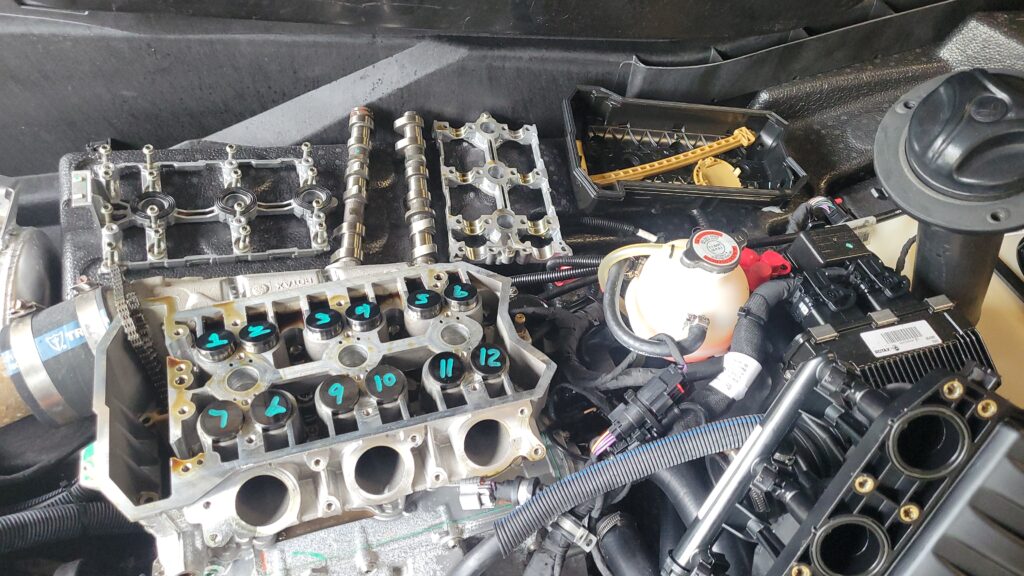At EJS Racing, we’ve seen our fair share of tricky repairs, but one of the most common headaches for jet ski and performance watercraft owners is dealing with a broken spark plug. A broken spark plug can bring your day on the water to a quick halt, and while there are various methods for removing a broken spark plug, we strongly recommend pulling the cylinder head off to ensure a clean and reliable fix. Here’s why:
1. Avoids Damage to the Engine
When a spark plug breaks, small fragments of metal or ceramic from the plug can fall into the combustion chamber. If left unattended, these pieces can cause severe damage, potentially leading to scoring, pitting, or even damaging the piston and cylinder walls. By pulling the cylinder head, you gain full access to the combustion chamber, allowing you to safely remove any debris before it causes further harm.
2. Prevents Drilling-Related Issues
One of the alternative methods for removing a broken spark plug involves drilling into the broken piece. However, this can be extremely risky. The drill bit can easily slip, especially when trying to work within the tight confines of the cylinder head. If this happens, the bit can dig into the soft aluminum that the cylinder head is made of, damaging the threads or the seating area for the spark plug.
Damaging the aluminum can lead to poor spark plug sealing, which not only affects engine performance but can also cause issues like misfires, loss of compression, or even more extensive engine damage down the road. Removing the cylinder head provides a much safer way to work, reducing the risk of damaging critical parts of your engine.
3. Ensures Complete Spark Plug Removal
Broken spark plugs often leave behind pieces like the threaded portion or electrodes, which can be difficult to remove without the proper access. Using extraction tools or drilling into the plug runs the risk of leaving even more debris inside the cylinder. By removing the cylinder head, you can work more carefully and with better visibility, ensuring that all remnants of the broken spark plug are removed properly.
4. Prevents Thread Damage
Attempting to remove a broken spark plug with the cylinder head still in place can risk damaging the spark plug threads inside the cylinder head. Any damage to these threads can lead to poor spark plug seating and compression issues later on, which will compromise the performance of your engine. When you pull the head off, you can inspect the threads carefully and repair them if necessary, ensuring a perfect seal when you install a new spark plug.
5. Better Access for Thorough Inspection
When a spark plug breaks, it’s often a sign that something else is wrong. By pulling the cylinder head, you can take a close look at the valves, combustion chamber, and piston for any signs of additional wear or damage. This allows for a more thorough inspection of the engine and can help you catch other potential issues before they escalate into bigger problems.
6. Precision Repair with Minimal Risk
While there are extraction tools that can remove broken spark plugs with the cylinder head in place, these methods can be risky, especially in performance watercraft where tolerances are tight, and any misstep can affect performance. Pulling the cylinder head may take more time, but it provides a more precise repair with minimal risk to your engine.
7. A Clean Slate for Reassembly
Once the cylinder head is off, you also have the opportunity to clean any carbon buildup or inspect gaskets and seals. Since you’re already doing a significant repair, this is a great chance to refresh your engine, improving its performance and longevity.
8. Peace of Mind
Perhaps the most important reason to pull the cylinder head is peace of mind. Knowing that you’ve fully removed the broken spark plug, inspected the combustion chamber, and addressed any potential issues means you can head back out on the water with confidence. You don’t have to worry about fragments, poor sealing, or further damage down the line.
Conclusion
At EJS Racing, we prioritize doing the job right the first time, even if it takes a bit more effort. Pulling the cylinder head off when removing a broken spark plug ensures a cleaner, safer, and more reliable repair. It’s an investment in the long-term health of your engine and guarantees you’ll be back on the water with your jet ski or performance watercraft running at its best.

